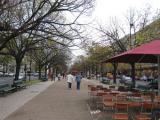 A cruise on the Yangzi River had been touted as a must-do in China and, although we had so recently cruised in Halong Bay in Vietnam, our curiosity got the best of us. If you don’t speak Chinese, there is disappointingly scarce information available regarding the cruises, the highlight of which is the opportunity to view the famed Three Gorges. From our hostel in Xi’an, we were able to book cruises but the staff had little knowledge of the details. The two options: an international cruise ship – very expensive; or a Chinese cruise ship for less than a third of the price. The international cruise had provided a snazzy color brochure; the Chinese ship was a total mystery. Your Honor, if it pleases the court, I would like the record to reflect that I lobbied against the Yangzi River cruise altogether.
A cruise on the Yangzi River had been touted as a must-do in China and, although we had so recently cruised in Halong Bay in Vietnam, our curiosity got the best of us. If you don’t speak Chinese, there is disappointingly scarce information available regarding the cruises, the highlight of which is the opportunity to view the famed Three Gorges. From our hostel in Xi’an, we were able to book cruises but the staff had little knowledge of the details. The two options: an international cruise ship – very expensive; or a Chinese cruise ship for less than a third of the price. The international cruise had provided a snazzy color brochure; the Chinese ship was a total mystery. Your Honor, if it pleases the court, I would like the record to reflect that I lobbied against the Yangzi River cruise altogether.
Despite the lukewarmth of my expressions, Aaron was quite determined and, since most of our boat experiences have been generally enjoyable, I acquiesced. With the international ship being understatedly cost prohibitive, we agreed on a second class cabin on the Chinese ship, the fare for which excluded all meals, drinks and excursions. We paid a thirty percent deposit at the hostel in Xi’an with the balance due the next day in Chongqing.
The sleeper train from Xi’an to Chongqing was like a ghost train. Not only did we have our entire four-bed cabin to ourselves but there was only one other passenger in the whole car and we didn’t even realize he was there until it was time to get off the train. The eleven-hour journey left us rested and we met our local booking agent, John, at the train station in Chongqing. He drove us, along with two young British girls, to his mini-hostel – John’s Cozy Nest – to spend the day. The eighth floor “nest” overlooking the Yangzi lived up to its name with a comfortable sitting area, cheap refreshments, free Wi-Fi, a shower, and John himself who was a generous wealth of knowledge. He spoke decent English and explained the details of the cruise, the prices and significance of the optional land excursions, and the transportation options at the tail end of the cruise. We would later discover that the English ended with John and he wasn’t coming with us.
We were happy to find that four British travelers – Eloise, Kayleigh, Michael and Katie – would be cruising with us. A wave of relief washed over us upon hearing this news as we half-expected to be the only foreigners on the Chinese cruise. Eloise and Kayleigh would share a second class cabin with us while Michael and Katie planned to endure a third class cabin. We made a trip to the supermarket in Chongqing to stock up on snacks, unsure about the canteen aboard the ship.
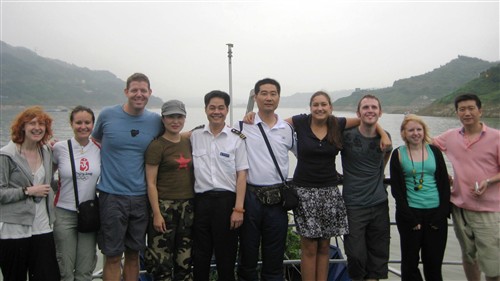
When 6:30 rolled around, John instructed the six of us to follow his brother to the ship. With our heavy packs and grocery bags in tow, we headed toward the parking lot but, rather than loading us into the mini-bus, John’s brother led us on a twenty-minute hike through the rain-soaked streets of Chongqing to the loading dock. There we were handed off to another Chinese man who handed us off to a Chinese woman who led us onto our ship amid a traffic jam of Chinese passengers, all with arms full of grocery bags.
The first things I noticed, as we boarded our Chinese cruise ship were the rippled, rusty painted metal deck and the foul stench of rotting fish and dirty water. The corridors were dim and the surfaces dingy. The experience recalled that same sense of innate hesitation that I felt upon boarding Captain Barracuda’s ship on the island of Lamu – my gut told me that something was fishy; that we should take the financial loss and get off the ship immediately. I voiced this to my husband who reacted with a chuckle.
The woman unlocked our cabin door and Aaron and I walked inside along with Eloise and Kaleigh. The cabin was small and cramped for four people with large backpacks, but we were all happy just to drop our bags. By some miracle, our claustrophobic cell of a washroom had a western toilet. The shower nozzle, which was almost directly above the toilet, initially spewed brown water. It was not a promising start but we were determined to make the best of it. The cabin was stuffy because the air conditioner was just sputtering to life so we congregated outside our door, looking out over the murky brown water into a dense fog.
Soon, a woman approached our group and beckoned us to follow her. She led us to the bow of the ship, into a small glassed-in lounge with a far door leading to an outer deck with blue plastic patio furniture. There were two middle-aged Chinese men chain-smoking in the lounge, working it into a hot box of cancer. This was the VIP area of the ship and the price of admission was 70 Yuan ($10), which included chairs, lung disease and all-you-can-drink Chinese tea. We all declined and returned to our rail, laughing all the way at the idea of paying for a VIP lounge when surely there was a furnished upper deck.
We decided to take a lap around the ship to explore its amenities. We spotted an indoor bar at the stern that would soon be packed with middle-aged Chinese chimneys, attended by a lone barman with black teeth. As we circled the ship, looking for the stairs to the upper deck, we soon came to the conclusion that there was no upper deck. We quickly deduced that, short of paying the VIP admission, there was literally no place for us to sit outside of our cramped, humid cabin. Since the others in our little group seemed adamant against the VIP idea, we all spent the remainder of the evening sitting on the rusted floor of the three-foot-wide walkway that spanned the perimeter of our deck. I nodded off to sleep that night knowing that I would not last the next three days without a chair.
Aaron and I woke early the next morning, sweating buckets because our air conditioner mysteriously stopped working around 2am. Also, the cleaning staff pounded on our cabin door at 6:45am to empty our trash. Both of these petty annoyances would occur on each morning of our cruise. We bought admission into the VIP lounge, encouraging the rest of our group to do the same. It was not the price of admission that we all struggled with but rather the principle of the matter. It is bad enough to pay a lot of money for a cruise that includes nothing but dingy, substandard accommodation but to have to pay more just for a place to sit is ludicrous. Eventually, everyone gave in and joined us. The first full day of our cruise was rainy and foggy and we passed the bulk of it by playing cards and attempting to visit over the single VIP television which blasted Chinese soap operas all day.
Having sustained ourselves on instant noodle cups, fruit and packaged snacks all day, we decided to try the canteen for dinner. The menu was entirely in Chinese, with no pictures, but we managed to order several dishes to share. We had kept our expectations very low and were shocked to find the food to be excellent. We all agreed that dinner was the highlight (the only light) of our Chinese cruise so far and were already looking forward to dinner the next night. By the way, many Brits refer to dinner as tea, which was initially confusing until we worked out the distinction. Breakfast is breakfast. Lunch is dinner. And dinner is tea. Also, we have found all of the Brits that we’ve met along the way to be exceedingly proper and possessing exquisite manners, which is decidedly endearing. We’ve not yet met a Brit that we didn’t like.
 On the second morning, we cruised through Qutang Gorge, the first of the Three Gorges. The day was foggy and it was raining again – the visibility left much to be desired – but the Chinese passengers flooded the outer VIP deck nonetheless to pose for endless photos. All of our group donned their rain gear and wandered outside to join the melee…all except for me. I simply didn’t find the view interesting enough to stand in the rain before my first cup of coffee. The gorge was a range of green contoured rock formations, very similar to Milford Sound in New Zealand. The formations were impressive but shrouded in such thick mist that they were almost completely obscured. I remained inside the glassed-in area of the VIP lounge, enjoying the views from my insulated vantage point. Then suddenly I saw it…the saddest, most forlorn little Bear face peering at me through the glass; he was holding his camera and umbrella and getting soaked from the blowing rain. My heart broke for that little frown and I raced to the cabin to get my rain poncho. God help me if my children have faces like that.
On the second morning, we cruised through Qutang Gorge, the first of the Three Gorges. The day was foggy and it was raining again – the visibility left much to be desired – but the Chinese passengers flooded the outer VIP deck nonetheless to pose for endless photos. All of our group donned their rain gear and wandered outside to join the melee…all except for me. I simply didn’t find the view interesting enough to stand in the rain before my first cup of coffee. The gorge was a range of green contoured rock formations, very similar to Milford Sound in New Zealand. The formations were impressive but shrouded in such thick mist that they were almost completely obscured. I remained inside the glassed-in area of the VIP lounge, enjoying the views from my insulated vantage point. Then suddenly I saw it…the saddest, most forlorn little Bear face peering at me through the glass; he was holding his camera and umbrella and getting soaked from the blowing rain. My heart broke for that little frown and I raced to the cabin to get my rain poncho. God help me if my children have faces like that.
The ship docked around noon at the site of the one additional excursion for which we had ponied up in advance – a separate five-hour cruise through the Lesser Three Gorges. We transferred to a smaller boat and found seats on the upper deck, along with all of the chain-smokers. Amazingly, after about twenty minutes, the rain subsided and the fog magically lifted for the remainder of our excursion. The Lesser Three Gorges were picturesque and stunning. The almost constant rain keeps the hillsides perpetually green and fertile – they were covered with plots of corn and other crops and small farming villages. Still, the most fascinating part of the Lesser Three Gorges cruise had nothing whatsoever to do with the gorges themselves.
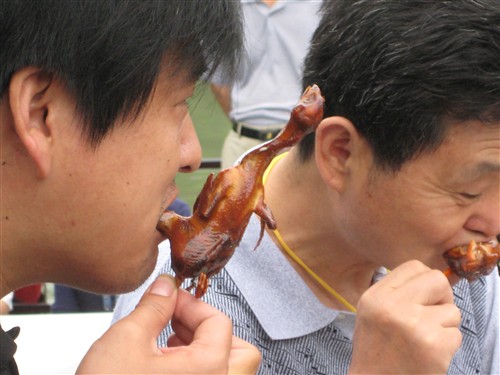 The Chinese have very different ideas about snacks. We have often seen displays of dried fish and grotesque-looking cooked animal parts that sit out on tables all day. One of our most interesting finds at the supermarket was a pile of dried pig faces preserved in the same petrified manner as the pig ears sold for dogs in the States. Refreshments were available for purchase on the ship and a woman walked around the deck, peddling whole juvenile roasted chickens from a bucket. The whole skewered birds couldn’t have had more meat on them than an average drumstick but I was dying to see someone eat one. There were no takers in our group despite my repeated double dares.
The Chinese have very different ideas about snacks. We have often seen displays of dried fish and grotesque-looking cooked animal parts that sit out on tables all day. One of our most interesting finds at the supermarket was a pile of dried pig faces preserved in the same petrified manner as the pig ears sold for dogs in the States. Refreshments were available for purchase on the ship and a woman walked around the deck, peddling whole juvenile roasted chickens from a bucket. The whole skewered birds couldn’t have had more meat on them than an average drumstick but I was dying to see someone eat one. There were no takers in our group despite my repeated double dares.
Finally, to all of the Westerners’ shock and delight, a group of four Chinese chain-smokers emerged from the lower deck with a bottle of spirits and a huge plate of the “chicks-on-a-stick”. We all stared, completely captivated, as the men tore into the little birds, biting their heads off, devouring them hungrily, working their way through the bodies and spitting the bones anywhere and everywhere. The Westerners on board rather insensitively surrounded their table with cameras but, despite the potential for offense, we couldn’t help ourselves. How often do you see someone bite the head off a baby chicken?
 Back on the big boat, we endured the rest of our Yangzi River cruise amid more rain and dense fog. While we would NEVER endeavor to repeat the experience and would strongly discourage anyone else from doing so, we must confess the fascinating insight that we have gained into Chinese culture. After “vacationing” among a ship full of Chinese passengers, we have amassed a collection of observations. They love to play cards and the men smoke like chimneys. Yelling is a part of normal conversation. They hock up mucus and spit incessantly (probably from the pollution and smoking) and often on the floor. They laugh a lot and seem generally cheerful. They largely ignored our presence on the ship and when they did watch us, it was with curiosity rather than disdain. They generally woke early and slept away the afternoons. They smoke incessantly, seemingly oblivious to the fact that they are plaguing those around them with contaminated air. I tried to get the message across by strapping on a double-layer of hospital masks whenever they lit up in my presence but it had no effect. Hopefully, the masks limited the cancer-causing filth that infiltrated my shrine.
Back on the big boat, we endured the rest of our Yangzi River cruise amid more rain and dense fog. While we would NEVER endeavor to repeat the experience and would strongly discourage anyone else from doing so, we must confess the fascinating insight that we have gained into Chinese culture. After “vacationing” among a ship full of Chinese passengers, we have amassed a collection of observations. They love to play cards and the men smoke like chimneys. Yelling is a part of normal conversation. They hock up mucus and spit incessantly (probably from the pollution and smoking) and often on the floor. They laugh a lot and seem generally cheerful. They largely ignored our presence on the ship and when they did watch us, it was with curiosity rather than disdain. They generally woke early and slept away the afternoons. They smoke incessantly, seemingly oblivious to the fact that they are plaguing those around them with contaminated air. I tried to get the message across by strapping on a double-layer of hospital masks whenever they lit up in my presence but it had no effect. Hopefully, the masks limited the cancer-causing filth that infiltrated my shrine.
Thankfully, we had a group of good-humored comrades with whom we could share and laugh our way through this bizarre cruise experience.
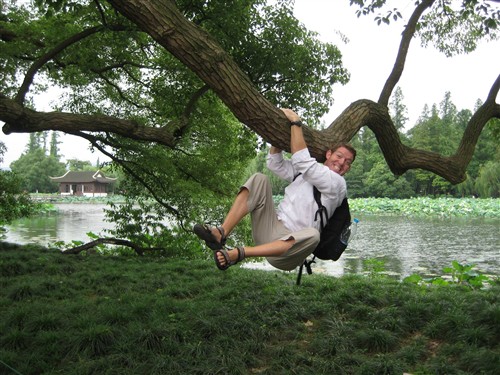 We boarded the morning train in Shanghai, and, after a wonderfully comfortable ride, reached Hangzhou by lunchtime. We had already booked seats on the 6:30p train back to Shanghai, which left us with just over six hours to explore. We took the city bus to West Lake in the center of the city. Hopping off the bus at the first sign of water, we grabbed a bite of lunch and then rented a pair of bikes to ride around the lake. A nice wide sidewalk bordered the lake but we soon learned that no bikes were allowed on it. After only fifteen minutes, we returned the bikes and began an hours-long stroll on the sidewalk. The surface of the lake was a pale blue that blended with the hazy sky. We spent the day walking leisurely, stopping to rest when we found a particularly pretty place. The lake was sectioned off by land bridges and islands, which made it seem like many lakes, each with its own unique atmosphere with gardens, parks, boats, pagodas and pavilions.
We boarded the morning train in Shanghai, and, after a wonderfully comfortable ride, reached Hangzhou by lunchtime. We had already booked seats on the 6:30p train back to Shanghai, which left us with just over six hours to explore. We took the city bus to West Lake in the center of the city. Hopping off the bus at the first sign of water, we grabbed a bite of lunch and then rented a pair of bikes to ride around the lake. A nice wide sidewalk bordered the lake but we soon learned that no bikes were allowed on it. After only fifteen minutes, we returned the bikes and began an hours-long stroll on the sidewalk. The surface of the lake was a pale blue that blended with the hazy sky. We spent the day walking leisurely, stopping to rest when we found a particularly pretty place. The lake was sectioned off by land bridges and islands, which made it seem like many lakes, each with its own unique atmosphere with gardens, parks, boats, pagodas and pavilions.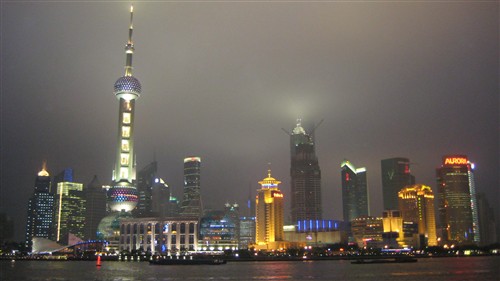
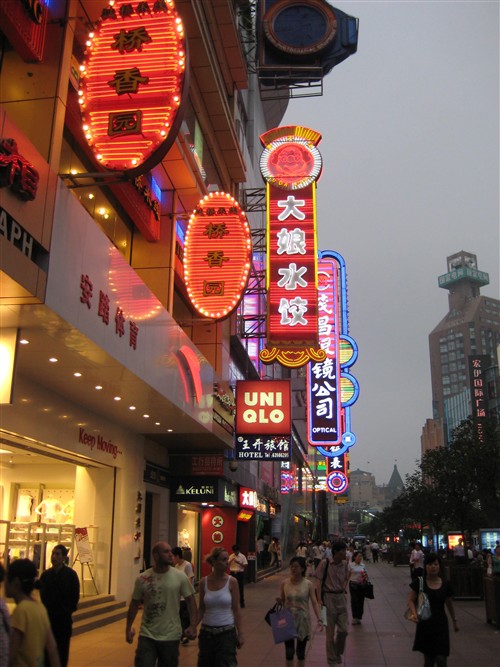 We headed down East Nanjing Road on a wide pedestrian walkway lined with several stories of restaurants, retail shops, billboards and flashy neon signs with Chinese characters. The walkway was crowded with walkers and we were almost incessantly pestered by people peddling cheap watches, jewelry, handbags, leather goods and electronics. None of them spoke more than a few words of English but they were all quite assured that they had what we wanted, whatever it might be. They all had identical laminated picture cards showing an array of tacky accessories. The street itself was a spectacle, both fascinating and dizzying, with bright lights and people everywhere. We walked the length of it to the Bund, a famous street in Shanghai where a grand façade of Old European buildings face the modern architecture of the Pudong skyline across the Huangpu River. An elevated promenade along the west bank of the river was bustling with tourists and locals alike, taking in Shanghai’s best views.
We headed down East Nanjing Road on a wide pedestrian walkway lined with several stories of restaurants, retail shops, billboards and flashy neon signs with Chinese characters. The walkway was crowded with walkers and we were almost incessantly pestered by people peddling cheap watches, jewelry, handbags, leather goods and electronics. None of them spoke more than a few words of English but they were all quite assured that they had what we wanted, whatever it might be. They all had identical laminated picture cards showing an array of tacky accessories. The street itself was a spectacle, both fascinating and dizzying, with bright lights and people everywhere. We walked the length of it to the Bund, a famous street in Shanghai where a grand façade of Old European buildings face the modern architecture of the Pudong skyline across the Huangpu River. An elevated promenade along the west bank of the river was bustling with tourists and locals alike, taking in Shanghai’s best views.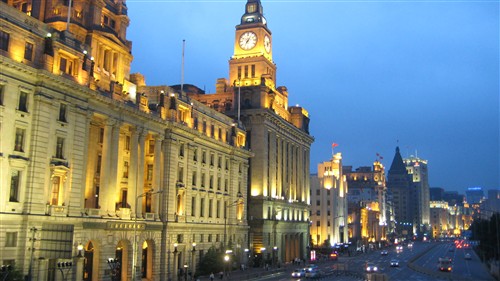
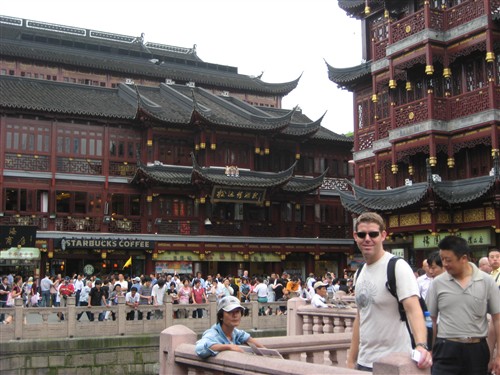 The afternoon was for Yuyuan Garden in Old Town Shanghai. The gardens were first established in 1559 and took eighteen years to cultivate. They were ravaged once during the Opium War and later by the French in retaliation for Chinese impediment on their concession. (Lonely Planet: China, May 2007) The gardens have since been revived and are now one of the most popular tourist sights in Shanghai. The entrance was a bazaar of antique wooden buildings surrounding a glittering lake. The buildings were occupied by shops and restaurants, including Starbucks and Dairy Queen (the Chinese LOVE ice cream – it’s EVERYWHERE, much to Aaron’s delight). True to its reputation, Yuyuan Garden was thronged with tourists. We fought the crowds through the teeming bazaar to the garden where the ambience was considerably more serene. Inside the confines of the garden walls, wooden pavilions and halls were built upon artistic, porous rock formations. Willow trees wept over sparkling carp ponds. Rock gardens and centuries-old, meticulously-pruned trees decorated the edges of every pond and wall. As we wandered through the picturesque perfection of the gardens, we felt a renewed sense of excitement about China. Amid the plethora of unsavory cultural differences and discomforts is an abundance of unique and diversely framed windows into the history of a vast nation that, for better or worse, influenced almost all of Asia in building and landscape architecture, technology, language and culture.
The afternoon was for Yuyuan Garden in Old Town Shanghai. The gardens were first established in 1559 and took eighteen years to cultivate. They were ravaged once during the Opium War and later by the French in retaliation for Chinese impediment on their concession. (Lonely Planet: China, May 2007) The gardens have since been revived and are now one of the most popular tourist sights in Shanghai. The entrance was a bazaar of antique wooden buildings surrounding a glittering lake. The buildings were occupied by shops and restaurants, including Starbucks and Dairy Queen (the Chinese LOVE ice cream – it’s EVERYWHERE, much to Aaron’s delight). True to its reputation, Yuyuan Garden was thronged with tourists. We fought the crowds through the teeming bazaar to the garden where the ambience was considerably more serene. Inside the confines of the garden walls, wooden pavilions and halls were built upon artistic, porous rock formations. Willow trees wept over sparkling carp ponds. Rock gardens and centuries-old, meticulously-pruned trees decorated the edges of every pond and wall. As we wandered through the picturesque perfection of the gardens, we felt a renewed sense of excitement about China. Amid the plethora of unsavory cultural differences and discomforts is an abundance of unique and diversely framed windows into the history of a vast nation that, for better or worse, influenced almost all of Asia in building and landscape architecture, technology, language and culture.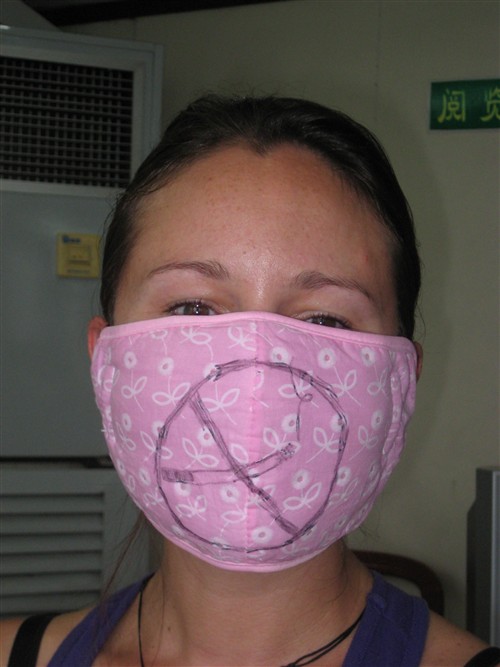 After our cruise on the Yangzi, we had a long, uncomfortable day of travel to Wuhan. Our cruise ship docked in Maoping where no English-speaking person could tell the group of confused- and frustrated-looking foreigners which public bus went to Yichang. By some miracle, we did make it onto the right bus and were delivered to the bus station in Yichang, where someone was supposed to be waiting with a sign. No such person was there so we dropped our bags on the front steps of the station and waited.
After our cruise on the Yangzi, we had a long, uncomfortable day of travel to Wuhan. Our cruise ship docked in Maoping where no English-speaking person could tell the group of confused- and frustrated-looking foreigners which public bus went to Yichang. By some miracle, we did make it onto the right bus and were delivered to the bus station in Yichang, where someone was supposed to be waiting with a sign. No such person was there so we dropped our bags on the front steps of the station and waited. A cruise on the Yangzi River had been touted as a must-do in China and, although we had so recently cruised in Halong Bay in Vietnam, our curiosity got the best of us. If you don’t speak Chinese, there is disappointingly scarce information available regarding the cruises, the highlight of which is the opportunity to view the famed Three Gorges. From our hostel in Xi’an, we were able to book cruises but the staff had little knowledge of the details. The two options: an international cruise ship – very expensive; or a Chinese cruise ship for less than a third of the price. The international cruise had provided a snazzy color brochure; the Chinese ship was a total mystery. Your Honor, if it pleases the court, I would like the record to reflect that I lobbied against the Yangzi River cruise altogether.
A cruise on the Yangzi River had been touted as a must-do in China and, although we had so recently cruised in Halong Bay in Vietnam, our curiosity got the best of us. If you don’t speak Chinese, there is disappointingly scarce information available regarding the cruises, the highlight of which is the opportunity to view the famed Three Gorges. From our hostel in Xi’an, we were able to book cruises but the staff had little knowledge of the details. The two options: an international cruise ship – very expensive; or a Chinese cruise ship for less than a third of the price. The international cruise had provided a snazzy color brochure; the Chinese ship was a total mystery. Your Honor, if it pleases the court, I would like the record to reflect that I lobbied against the Yangzi River cruise altogether.
 On the second morning, we cruised through Qutang Gorge, the first of the Three Gorges. The day was foggy and it was raining again – the visibility left much to be desired – but the Chinese passengers flooded the outer VIP deck nonetheless to pose for endless photos. All of our group donned their rain gear and wandered outside to join the melee…all except for me. I simply didn’t find the view interesting enough to stand in the rain before my first cup of coffee. The gorge was a range of green contoured rock formations, very similar to Milford Sound in New Zealand. The formations were impressive but shrouded in such thick mist that they were almost completely obscured. I remained inside the glassed-in area of the VIP lounge, enjoying the views from my insulated vantage point. Then suddenly I saw it…the saddest, most forlorn little Bear face peering at me through the glass; he was holding his camera and umbrella and getting soaked from the blowing rain. My heart broke for that little frown and I raced to the cabin to get my rain poncho. God help me if my children have faces like that.
On the second morning, we cruised through Qutang Gorge, the first of the Three Gorges. The day was foggy and it was raining again – the visibility left much to be desired – but the Chinese passengers flooded the outer VIP deck nonetheless to pose for endless photos. All of our group donned their rain gear and wandered outside to join the melee…all except for me. I simply didn’t find the view interesting enough to stand in the rain before my first cup of coffee. The gorge was a range of green contoured rock formations, very similar to Milford Sound in New Zealand. The formations were impressive but shrouded in such thick mist that they were almost completely obscured. I remained inside the glassed-in area of the VIP lounge, enjoying the views from my insulated vantage point. Then suddenly I saw it…the saddest, most forlorn little Bear face peering at me through the glass; he was holding his camera and umbrella and getting soaked from the blowing rain. My heart broke for that little frown and I raced to the cabin to get my rain poncho. God help me if my children have faces like that. The Chinese have very different ideas about snacks. We have often seen displays of dried fish and grotesque-looking cooked animal parts that sit out on tables all day. One of our most interesting finds at the supermarket was a pile of dried pig faces preserved in the same petrified manner as the pig ears sold for dogs in the States. Refreshments were available for purchase on the ship and a woman walked around the deck, peddling whole juvenile roasted chickens from a bucket. The whole skewered birds couldn’t have had more meat on them than an average drumstick but I was dying to see someone eat one. There were no takers in our group despite my repeated double dares.
The Chinese have very different ideas about snacks. We have often seen displays of dried fish and grotesque-looking cooked animal parts that sit out on tables all day. One of our most interesting finds at the supermarket was a pile of dried pig faces preserved in the same petrified manner as the pig ears sold for dogs in the States. Refreshments were available for purchase on the ship and a woman walked around the deck, peddling whole juvenile roasted chickens from a bucket. The whole skewered birds couldn’t have had more meat on them than an average drumstick but I was dying to see someone eat one. There were no takers in our group despite my repeated double dares. Back on the big boat, we endured the rest of our Yangzi River cruise amid more rain and dense fog. While we would NEVER endeavor to repeat the experience and would strongly discourage anyone else from doing so, we must confess the fascinating insight that we have gained into Chinese culture. After “vacationing” among a ship full of Chinese passengers, we have amassed a collection of observations. They love to play cards and the men smoke like chimneys. Yelling is a part of normal conversation. They hock up mucus and spit incessantly (probably from the pollution and smoking) and often on the floor. They laugh a lot and seem generally cheerful. They largely ignored our presence on the ship and when they did watch us, it was with curiosity rather than disdain. They generally woke early and slept away the afternoons. They smoke incessantly, seemingly oblivious to the fact that they are plaguing those around them with contaminated air. I tried to get the message across by strapping on a double-layer of hospital masks whenever they lit up in my presence but it had no effect. Hopefully, the masks limited the cancer-causing filth that infiltrated my shrine.
Back on the big boat, we endured the rest of our Yangzi River cruise amid more rain and dense fog. While we would NEVER endeavor to repeat the experience and would strongly discourage anyone else from doing so, we must confess the fascinating insight that we have gained into Chinese culture. After “vacationing” among a ship full of Chinese passengers, we have amassed a collection of observations. They love to play cards and the men smoke like chimneys. Yelling is a part of normal conversation. They hock up mucus and spit incessantly (probably from the pollution and smoking) and often on the floor. They laugh a lot and seem generally cheerful. They largely ignored our presence on the ship and when they did watch us, it was with curiosity rather than disdain. They generally woke early and slept away the afternoons. They smoke incessantly, seemingly oblivious to the fact that they are plaguing those around them with contaminated air. I tried to get the message across by strapping on a double-layer of hospital masks whenever they lit up in my presence but it had no effect. Hopefully, the masks limited the cancer-causing filth that infiltrated my shrine.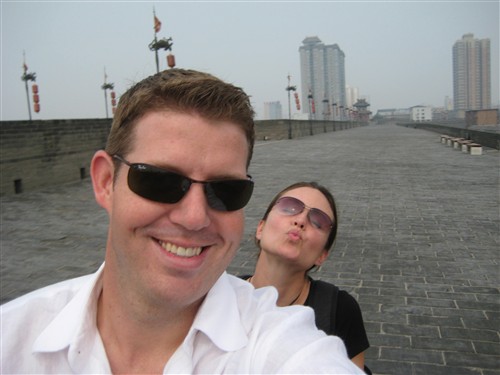 Giant, cuddly, loveable pandas, or panders as the Chinese call them, were on the itinerary for our third day in Xi’an. We hired a driver from our hostel to make the two hour drive to a WWF (World Wildlife Federation)-sponsored wildlife sanctuary.
Giant, cuddly, loveable pandas, or panders as the Chinese call them, were on the itinerary for our third day in Xi’an. We hired a driver from our hostel to make the two hour drive to a WWF (World Wildlife Federation)-sponsored wildlife sanctuary.